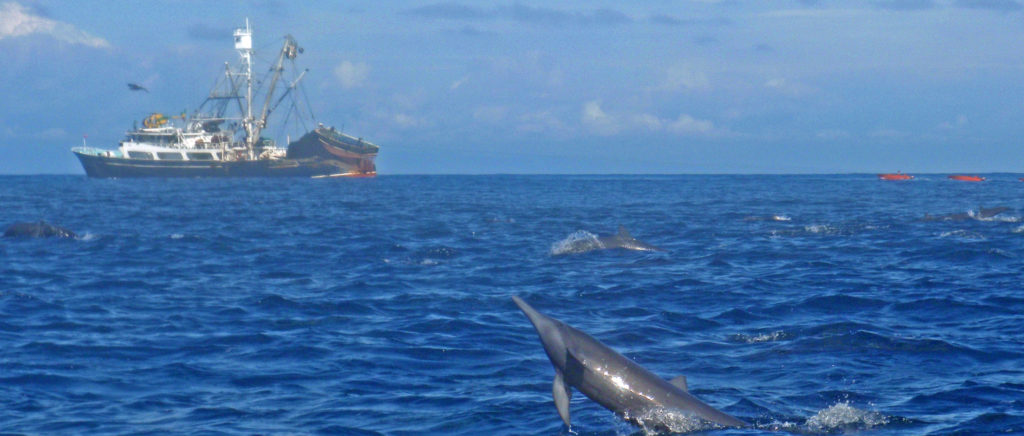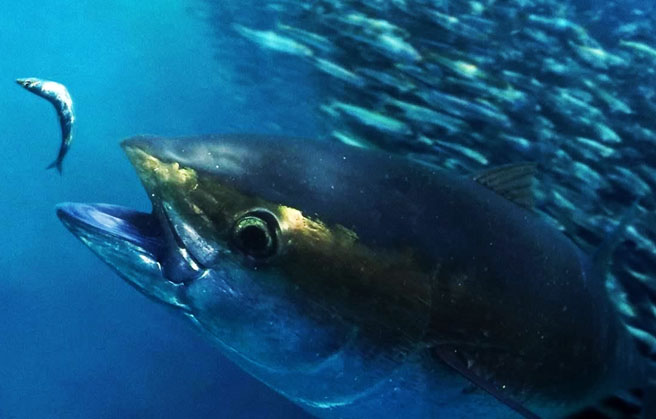Tuna Fishing Methods Cause Conflict, Kill Dolphins
By Mike McDonald Tico Times
August 6th, 2010
The Billfish Foundation sent a formal letter Aug. 8 to Costa Rican President Laura Chinchilla urging her to investigate recent attacks on sport fishing vessels in Costa Rican waters.
The letter came one week after crew members aboard the Silver Rod O – a U.S.-based sportfishing boat owned by Gary Carter, a member of the Fort Lauderdale, Florida-based nonprofit foundation – reported being assaulted with incendiary devices by a Venezuelan tuna purse seiner named La Rosa Mística.The alleged attack occurred off the Nicoya Peninsula, in northwestern Costa Rica.
A purse seiner or seine boat is a vessel with nets hanging vertically in the water whose ends can be drawn together like a purse to enclose fish.
“We are respectfully asking that your administration immediately initiate an investigation into this incident and take appropriate action against the captain and owners of La Rosa Mística,” the letter stated. “We fear that … similar future actions will ultimately lead to injury or death at sea.”

In an afternoon press conference Tuesday, Aug. 10, Chinchilla said she was aware of the letter. She acknowledged that Costa Rica does not wish to allow such episodes in its waters and said that she is “directing the issue to the Public Security Ministry.”
“We are not going to permit any activity that has a negative impact on tourism or sport fishing or on any other sector that could be affected by this kind of situation,” she said. “We will see if we are going to file a complaint, but I am confident that the Public Security Ministry will make the right choice regarding this matter.”
On Aug. 1, guests aboard the Silver Rod O were fishing for billfish near schools of spinner dolphin and yellow-fin tuna when they claim a helicopter from La Rosa Mística began to circle the boat.
According to the anglers, the chopper dropped several explosives into the water, some landing within 50 meters of the Silver Rod O, while La Rosa Mistica allegedly charged toward the sport fishermen.
“It was threatening,” Carter said. “They were trying to either encircle us into their net or to plow us into the sea unless we abandoned the school of dolphin.”
According to Carter, the Silver Rod O retreated, and no one on board was hurt.
La Rosa Mística is owned by Ingopesca S.A., a Venezuelan seafood export company.
The Tico Times called Ingopesca S.A.seeking a comment on the incident, but was told that the person in charge of the case was out of the office. An e-mail containing questions was sent to an Ingopesca S.A. representative, but no response was received by press time.
Luis Dobles, executive president of the Costa Rican Fisheries Institute (Incopesca), told The Tico Times that his organization is evaluating the possibility of filing a formal complaint against the Venezuelan ship for harassment and for the use of explosive devices.
Costa Rica’s Fishing and Aquiculture Law prohibits the use of any type of explosive in the country’s waters.
Since2008, Incopesca has filed three formal complaints for similar attacks on Costa Rican boats. One was rejected for lack of evidence.
While fishing with explosives is illegal in Costa Rica, the practice is not uncommon here.
Shawn Larkin, Tico Times columnist and dive instructor for Aquamor Talamanca Adventures in Manzanillo on the Caribbean coast, said that tuna purse seine vessels often drop explosives in the water in order to corral spinner dolphins.
Because tuna depend on some of the same food as spinner dolphins, tuna often follow the mammals during feeding time.
Tuna fishermen have learned that by corralling the dolphins – which are easily seen near the surface of the water – they can also round up a hefty catch of tuna.
And while effective, the use of these explosives harms and even kills marine life.
“I have seen the explosives kill dolphins, turtles, rays and fish,” Larkin said. “But the real damage is done by the nets.”
Crews aboard the tuna purse seine vessels must ensure that all untargeted animals escape the circular traps before pulling the catch aboard. But Larkin estimates that in some areas of Costa Rica these nets kill nearly 30 dolphins per day.
“They die most frequently when their narrow, smiling mouths get stuck in the holes of the net,” he said. “Hundreds more must be manhandled by a diving crew and thrown out of the nets daily lest the nets are damaged. The freed spinner dolphins are often damaged and freaked out.”
When sport fishing and tour boats obstruct their access to dolphin and tuna populations, tuna purse seine boats often resort to drastic measures to seize the haul.

Larkin said that he has witnessed helicopters from seine liners throw beer cans at nearby cruisers and hold up automatic weapons in order to frighten tourist boats away from schools of spinner dolphins.
Carter,the owner of Silver-Rod-O, said that when he steered his ship away from La Rosa Mística, the Venezuelan crew “closed its nets and obnoxiously celebrated its victory.”
According to The Billfish Foundation, 10 vessels have been “attacked” in Costa Rican waters by foreign-flagged tuna seine ships since 2008.
“The Costa Rican government has to do something to show these foreign seiners that this sort of behavior will not be tolerated,” said Ellen Peel, president of The Billfish Foundation.
While Incopesca is in charge of monitoring these waters, Dobles said that the organization’s small fleet can’t reach all areas at all times. He added that the Costa Rican Coast Guard, who would normally assist in fishing patrols, has been busy searching for drug traffickers in recent years.
In order to avoid confrontations between sport fishing vessels and tuna seine ships, Peel recommends imposing stricter limits on purse seine ships’ proximityto shore.
La Rosita Mística was fishing just outside the legal distance of 12 miles from the coast, Dobles said.
Peel advises that Costa Rica force purse seine vessels to fish at least 50 miles from shore. This, she said,would help preserve fish stocks and help prevent further conflicts.
Guatemala requires purse seine tuna boats to fish at least 110 miles from the coastline. Last month, Panamanian President Ricardo Martinelli, signed an executive decree banning purse-seine fishing in Panamanian waters.
Dobles said that such limits are “always on the table,” but said that for Costa Rica to impose such restrictions, it would have to consult the Inter-American Tropical Tuna Commission, of which the country is a member.
“We can’t just expand the limits without taking into consideration the vision of the Commission,” he said. “We have to allow for a certain amount of fishing because we need to satisfy the need for jobs here and at tuna canning plants. Everything has to be balanced.”
Guatemala and Panama are also members of the commission.
But Peel warned that, if the issue is neglected for too long, Costa Rica could see start to see drawbacks.
“If Costa Rica won’t address this sort of outrage, and also take better care of the marine resources like the sailfish and marlin that drive this economic engine, they will quickly find people moving elsewhere and taking their money with them,”she said.
More Costa Rica Fishing Articles from FECOP
[post-carousel-pro id=”5407″]
Related Conservation Articles from FECOP
Yellowfin Tuna: Costa Rica’s Blood Diamond
Explaining the Costa Rica Tuna Decree
Stop Illegal Fishing in Costa Rica
Developments Impacting Sport Fishing in Costa Rica
Costa Rica’s Fisherman want Access to Local Tuna





















